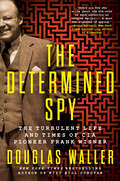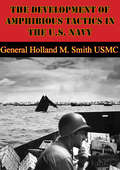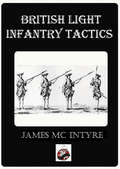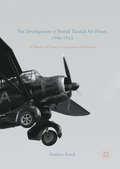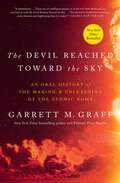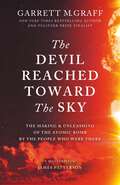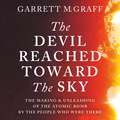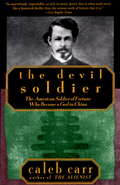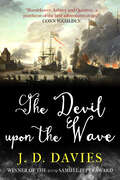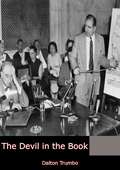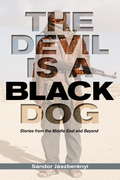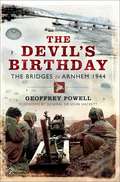- Table View
- List View
The Detective's Undoing
by Jill ShalvisDon't miss the conclusion to New York Times bestselling author Jill Shalvis's classic series, The Heirs to the Triple M!Cade McKnight was a loner. A man who liked his horizons open. Then the private investigator met Delia Scanlon. The sexy spitfire drove Cade to distraction, unleashed his tightly controlled emotions and made him feel alive again. But Cade had been hired to find out whether Delia had a true claim to the ranch, not to sleep with his alluring client. Besides, Delia wants things Cade could never give her--a home, a family. And when he discovers the truth about her heritage, it could destroy both their dreams...
The Determined Spy: The Turbulent Life and Times of CIA Pioneer Frank Wisner
by Douglas WallerFrom Douglas Waller, New York Times bestselling author of Wild Bill Donovan, an intimate and expertly researched biography of little-known early CIA leader Frank Wisner, whose behind-the-scenes influence on Cold War policy--and hundreds of highly secret anti-Soviet missions--resonates with the international crises we see today. Frank Wisner was one of the most powerful men in 1950s Washington, though few knew it. Reporting directly to senior U.S. officials--his work largely hidden from Congress and the public-- Wisner masterminded some of the CIA&’s most daring and controversial operations in the early years of the Cold War, commanding thousands of clandestine agents around the world. Following an early career marked by exciting escapades as a key World War II spy under General William &“Wild Bill&” Donovan, Wisner quickly rose through the postwar intelligence ranks to lead a newly created top-secret unit tasked--under little oversight--with overseeing massive propaganda, economic warfare, sabotage, subversion, and guerrilla operations all over the world, including such daring initiatives as the CIA-backed coups in Iran and Guatemala. But simultaneously, Wisner faced a demon few at the time understood: bipolar disorder. When this debilitating disease resulted in his breakdown and transfer to a mental hospital, the repercussions were felt throughout Washington&’s highest levels of power. Waller&’s sensitive and exhaustively researched biography is the riveting story of both Frank Wisner as a national figure who inspired a cadre of future CIA secret warriors, and also an intimate and empathetic portrait of a man whose harrowing struggle with bipolar disorder makes his impressive accomplishments on the world stage even more remarkable.
The Development Of Amphibious Tactics In The U.S. Navy
by Brigadier General Edwin H. Simmons USMC General Holland M. Smith USMCFROM our entry into the war at Pearl Harbor in December 1941 until the Japanese surrender in September 1945, every major offensive campaign launched by the United States was initiated by an amphibious assault. Our landings at North Africa in November 1942, at Sicily and Italy in July and September 1943, and at Normandy and Southern France in June and September 1944 ended in the defeat of the German armies in Western Europe by the Allied Expeditionary Force in May 1945. The Pacific offensive, which began in the South Pacific with the landings at the Solomons in August 1942 and in the Central Pacific at the Gilberts in November 1943, carried us 3,000 miles to the Philippine Islands and 5,000 miles through to the inner defenses of the empire in the Volcano and Ryukyu Islands....Amphibious warfare was the primary offensive tactic in our conduct of global war.The tactics and techniques of our landing operations represent a new and significant development in the art of war. Although military history contains many instances of landing operations conducted by both military and navy forces in all parts of the world, from the early time man first crossed the sea to wage war, the landings were generally either limited in scope and purpose or unopposed. The feasibility of amphibious raids, in which assault forces landed from the sea are withdrawn after limited operations, and of unopposed landings, relying on surprise and conducted for the purpose of subsequent military operations ashore, has long been recognized. Until the recent war, however, the effect of modern defensive weapons was considered too decisive to permit successful assault from the sea. The development of radar, aviation, coast defense guns, torpedoes, submarines, mines, defensive obstructions and obstacles, automatic weapons, highly mobile reserves, and the necessary communication facilities to coordinate and control them seemed to present insurmountable difficulties to amphibious attack.
The Development Of German Doctrine And Command And Control And Its Application To Supporting Arms, 1832–1945
by Major Marvin Knorr Jr. USMCThis thesis describes how German doctrine and command and control evolved in World War II with respect to supporting arms. Structured knowledge of a subject, based on empirical data and experience, contributes to successful practice and future development. The German experience of the Second World War is used to discern the applicable lessons of command and control for understanding the development of modern warfare as it relates to supporting arms.
The Development of British Light Infantry
by James McintyreThe Development of British Light Infantry examines the development of light infantry in the British Army in general and North America specifically. This illustrated history is a must for anyone interested in military history
The Development of British Naval Aviation, 1914–1918 (Routledge Studies in Modern British History)
by Alexander HowlettThe Royal Naval Air Service (RNAS) revolutionized warfare at sea, on land, and in the air. This little-known naval aviation organization introduced and operationalized aircraft carrier strike, aerial anti-submarine warfare, strategic bombing, and the air defence of the British Isles more than 20 years before the outbreak of the Second World War. Traditionally marginalized in a literature dominated by the Royal Flying Corps and the Royal Air Force, the RNAS and its innovative practitioners, nevertheless, shaped the fundamentals of air power and contributed significantly to the Allied victory in the First World War. The Development of British Naval Aviation utilizes archival documents and newly published research to resurrect the legacy of the RNAS and demonstrate its central role in Britain’s war effort.
The Development of British Naval Thinking: Essays in Memory of Bryan Ranft (Cass Series: Naval Policy and History #Vol. 38)
by Geoffrey TillThis new book brings together Britain’s leading naval historians and analysts to present a comprehensive investigation of British naval thinking and what has made it so distinctive over the last three centuries, from the sailing ship era to the current day. This new volume describes in depth the beginnings of formalized thought about the conduct of naval operations in the 18th Century, its transformation through the impact of industrialization in the 19th Century and its application in the two World Wars of the twentieth. This book concludes with a review of modern British naval thinking and the appearance of naval doctrine against the uncertainties of the loss of empire, the Cold War, nuclear weapons and the huge changes facing us as we move in to the new millennium. How perceptive and distinctive was British naval thinking? Where did British ideas come from? Did they determine or merely follow British experience? Do they explain British naval success ? The contributors to this volume tackle these key questions in a book that will be of considerable interest to the maritime community around the English-speaking world. This book will be of great interest to all students and professionals with an interest in the history of the Royal Navy, contemporary British maritime operations and strategic studies. This is a commemorative volume of the life and work of the distinguished Professor Bryan Ranft.
The Development of British Tactical Air Power, 1940-1943
by Matthew PowellThis book explores the development of tactical air power in Britain between 1940 and 1943 through a study of the Royal Air Force's Army Co-operation Command. It charts the work done by the Command during its existence, and highlights the arguments between the RAF and Army on this contentious issue in Britain. Much is known about the RAF both in the years preceding and during the Second World War, particularly the exploits of Fighter, Bomber and Coastal Commands, yet the existence of the RAF's Army Co-operation Command is little-known. Through extensive archival research, Matthew Powell maps the creation and work of the RAF's Army Co-operation Command through an analysis of tactical air power developments during the First World War and inter-war periods, highlighting the debates and arguments that took place between the Air Ministry and the War Office.
The Development of Nuclear Propulsion in the Royal Navy, 1946-1975 (Security, Conflict and Cooperation in the Contemporary World)
by Gareth Michael JonesThis book examines the development of nuclear propulsion in the Royal Navy from the first proposal in 1946 to the start-up of the last core improvement for the first submarine reactor power plant PWR 1 in December 1974. Drawing from unreleased records and archives, the book answers questions around three main themes. Political: what problems were encountered in transferring nuclear knowledge from the USA to the UK in the post-war period, and how much support was there for the development of nuclear propulsion? Military: why was there a requirement to develop nuclear propulsion, and in particular, why submarines? Technical: were the problems associated with nuclear energy fully appreciated, and did the UK have the technical and engineering capability to develop nuclear propulsion? Aside from the political considerations and military motives for developing nuclear propulsion in the Royal Navy, the author focuses on the technical problems that had to be overcome by all participants in the Royal Navy’s development of nuclear propulsion, adding significantly to naval historiography. Providing a critical analysis of the political, technological, operational and industrial issues of introducing nuclear propulsion into the Royal Navy, the author situates his research in the context of the evolving Cold War, changing Anglo-American relations, the end of Empire and the relative decline of British power.
The Development of the German Air Force, 1919-1939
by Harry R. Fletcher Prof. Richard SuchenwirthThe Development of the German Air Force, 1919 to 1939, first published in 1968, written by Professor Richard Suchenwirth, and revised and edited by Mr. Harry R. Fletcher, is one of a series of historical studies written for the United States Air Force Historical Division by men who had been key officers in or outstanding authorities on the German Air Force during World War II.The overall purpose of the series is twofold: 1) To provide the United States Air Force with a comprehensive and, insofar as possible, authoritative history of a major air force which suffered defeat in World War II, a history prepared by many of the principal and responsible leaders of that air force; 2) to provide a firsthand account of that air force’s unique combat in a major war, especially its fight against the forces of the Soviet Union.This series of studies therefore covers in large part virtually all phases of the Luftwaffe’s operations and organization, from its camouflaged origin in the Reichswehr, during the period of secret rearmament following World War I, through its participation in the Spanish Civil War and its massive operations and final defeat in World War II, with particular attention to the air war on the Eastern Front.
The Devil Aspect: A Novel
by Craig Russell"A blood-pumping, nerve-shredding thriller--elegant, edgy, ingenious. Craig Russell conjures not one but two unforgettable settings: Prague between the wars, pulsing with menace, and a Gothic mental asylum, as exciting a house of horrors as I've ever visited. You'll enter both with dread. You'll dwell in them with relish."--A. J. Finn, #1 New York Times bestselling author of The Woman in the WindowPrague, 1935: Viktor Kosárek, a psychiatrist newly trained by Carl Jung, arrives at the infamous Hrad Orlu Asylum for the Criminally Insane. The state-of-the-art facility is located in a medieval mountaintop castle outside of Prague, though the site is infamous for concealing dark secrets going back many generations. The asylum houses the country's six most treacherous killers--known to the staff as The Woodcutter, The Clown, The Glass Collector, The Vegetarian, The Sciomancer, and The Demon--and Viktor hopes to use a new medical technique to prove that these patients share a common archetype of evil, a phenomenon known as The Devil Aspect. As he begins to learn the stunning secrets of these patients, five men and one woman, Viktor must face the disturbing possibility that these six may share another dark truth. Meanwhile, in Prague, fear grips the city as a phantom serial killer emerges in the dark alleys. Police investigator Lukas Smolak, desperate to locate the culprit (dubbed Leather Apron in the newspapers), realizes that the killer is imitating the most notorious serial killer from a century earlier--London's Jack the Ripper. Smolak turns to the doctors at Hrad Orlu for their expertise with the psychotic criminal mind, though he worries that Leather Apron might have some connection to the six inmates in the asylum. Steeped in the folklore of Eastern Europe, and set in the shadow of Nazi darkness erupting just beyond the Czech border, this stylishly written, tightly coiled, richly imagined novel is propulsively entertaining, and impossible to put down.
The Devil Claims a Wife
by Helen DicksonGuy St. Edmond, returning warrior, will let nothing stand in the way of his desireSpoken of only in whispers-and with a name that strikes fear into the hearts of his enemies-Guy St. Edmond wields his ancient sword like the Devil and his charm like a weapon. Confronted with a woman who does not cower before him, he finds his interest is aroused-but Jane Lovet is sworn to another.Yet her engagement is soon broken by Guy's ruthless intervention, causing a scandal that echoes around the royal court. Forced into marriage, he can't deny that having the desirable Jane at his side night after night promises untold pleasures....
The Devil Himself: The Mutiny of 1800
by Dudley PopeThe French corvette La Vaillante, built in 1796, was captured and renamed Danae by the British Royal Navy in 1798. Two years later, she was returned to France in an amazing fashion: her British crew mutinied, sailed the Danae to France, and turned her over to the enemy for a cash reward. Accurate, fair, thorough, and lively, this penetrating account of a mutiny and its aftermath is compiled from contemporary British documents and the dusty French naval archives. Dudley Pope describes the men, the ship, and the tragic chain of events following their capture by a press-gang, bringing this extraordinary 1800 mutiny to life and chronicling those who survived, hanged, or died disgraced in a far-off colonial posting. This history is also significant in that it inspired Pope to try his hand at fiction, resulting in the Lord Ramage novels. The historical figures and events found in this true story are the basis for some of the favorite fictional characters and plot elements in Pope&’s novels.
The Devil Reached Toward the Sky: An Oral History of the Making and Unleashing of the Atomic Bomb
by Garrett M. Graff“Magisterial…A stunning account that brings to the fore the nuclear saga’s surreal combination of ingenuity, fate, and terror.” —Publishers Weekly (starred review) • “If you are an intelligent person, or at the very least think you are, you have to read The Devil Reached Toward the Sky…This period in history has never been more relevant and frightening than it is today.” —James Patterson • “Comprehensive and engrossing…Excellent oral history.” —Kirkus Reviews <p> On the 80th anniversary of the Hiroshima and Nagasaki bombings, the Pulitzer Prize finalist whose work is “oral history at its finest” (Pittsburgh Post-Gazette) delivers an epic narrative of the atomic bomb’s creation and deployment, woven from the voices of hundreds of scientists, generals, soldiers, and civilians. <p> The building of the atomic bomb is the most audacious undertaking in human history: a rush by a small group of scientists and engineers in complete secrecy to unlock the most fundamental power of the universe. Even today, the Manhattan Project evokes boldness, daring, and the grandest of dreams: bringing an end to World War II in the Pacific. As Marines, soldiers, sailors, and airmen fight overseas, men and women strive to discover the atom’s secrets in places like Chicago, Berkeley, Oak Ridge, Hanford, and Los Alamos. On August 6, 1945, the world discovers what the end of the war—and the new global age—will look like. <p> The road to the first atomic bomb ends in Hiroshima, Japan, but it begins in Hitler’s Europe, where brilliant physicists are forced to flee fascism and antisemitism—bringing to America their determination to harness atomic power before it falls into the Führer’s arsenal. The Devil Reached Toward the Sky traces the breakthroughs and the breakneck pace of atomic development in the years leading up to 1945, then takes us inside the B-29 bombers carrying Little Boy and Fat Man and finally to ground zero at Hiroshima and Nagasaki. <p> From Pulitzer Prize finalist Garrett M. Graff, The Devil Reached Toward the Sky is the panoramic narrative of how ordinary people grapple with extraordinary wartime risks, sacrifices, and choices that will transform the course of history. Engineers experiment with forces of terrifying power, knowing each passing day costs soldiers&’ lives—but fearing too the consequences of their creation. Hundreds of thousands of workers toil around the clock to produce uranium and plutonium in an endeavor so classified that most people involved learn the reality of their effort only when it is announced on the radio by President Truman. <p> The 509th Composite Group trains for a mission whose details are kept a mystery until shortly before takeoff, when the Enola Gay and Bockscar are loaded with bombs the crew has never seen. And the civilians of two Japanese cities that have been spared American attacks—preserved for the sake of judging the bomb’s power—escape their pulverized homes into a greater hellscape. Drawing from dozens of oral history archives and hundreds of books, reports, letters, and diaries from across the US, Japan, and Europe, Graff masterfully blends the memories and perspectives from the known and unknown—key figures like J. Robert Oppenheimer, General Leslie Groves, and President Truman; the crews of the B-29 bombers; and the haunting stories of the Hibakusha—the “bomb-affected people.” Both a testament to human ingenuity and resilience and a compelling drama told by the participants who lived it, The Devil Reached Toward the Sky is a singular, profound, and searing book about the inception of our most powerful weapon and its haunting legacy. <p> <b>New York Times Bestseller</b>
The Devil Reached Toward the Sky: The Making and Unleashing of the Atomic Bomb - By The People Who Were There
by Garrett M. Graff'Magisterial...A stunning account that brings to the fore the nuclear saga's surreal combination of ingenuity, fate, and terror.' -Publishers Weekly (starred review)'If you are an intelligent person, or at the very least think you are, you have to read The Devil Reached Toward the Sky...This period in history has never been more relevant and frightening than it is today.' -James Patterson 'Comprehensive and engrossing...Excellent oral history.' -Kirkus ReviewsFrom the New York Times bestselling author of When the Sea Came Alive and The Only Plane in the Sky, a sweeping and comprehensive oral history of the atomic bomb's creation and deployment, marking the 80th anniversary of Hiroshima and Nagasaki.April 12, 1945. Less than three months into his vice presidency, Harry Truman is catapulted into the Oval Office following the sudden death of Franklin D. Roosevelt. As he recites the oath, he learns a chilling secret known only to a select few: the United States is on the verge of deploying a weapon of unimaginable power. This weapon could end the war but also herald a new age of global fear and uncertainty.Drawing from over twenty-five oral history archives across the US, Japan, and Europe, Graff has masterfully blended the memories and perspectives from key figures like Harry Truman and J. Robert Oppenheimer, the crews of the B-29 bombers, Enola Gay and Bock's Car, the rescuers who bravely faced the destruction, and the haunting stories of those at ground zero in Hiroshima and Nagasaki, including the experiences of the hibakusha - the 'bomb-affected people'.Enriched by memoirs, diaries, letters, official documents, and news reports, this is an immersive and deeply human account of the Manhattan Project through the end of World War II and the dawning of the Cold War, offering a vivid, multi-dimensional view of events that reshaped the world forever.
The Devil Reached Toward the Sky: The Making and Unleashing of the Atomic Bomb - By The People Who Were There
by Garrett M. Graff'Magisterial...A stunning account that brings to the fore the nuclear saga's surreal combination of ingenuity, fate, and terror.' -Publishers Weekly (starred review)'If you are an intelligent person, or at the very least think you are, you have to read The Devil Reached Toward the Sky...This period in history has never been more relevant and frightening than it is today.' -James Patterson 'Comprehensive and engrossing...Excellent oral history.' -Kirkus ReviewsFrom the New York Times bestselling author of When the Sea Came Alive and The Only Plane in the Sky, a sweeping and comprehensive oral history of the atomic bomb's creation and deployment, marking the 80th anniversary of Hiroshima and Nagasaki.April 12, 1945. Less than three months into his vice presidency, Harry Truman is catapulted into the Oval Office following the sudden death of Franklin D. Roosevelt. As he recites the oath, he learns a chilling secret known only to a select few: the United States is on the verge of deploying a weapon of unimaginable power. This weapon could end the war but also herald a new age of global fear and uncertainty.Drawing from over twenty-five oral history archives across the US, Japan, and Europe, Graff has masterfully blended the memories and perspectives from key figures like Harry Truman and J. Robert Oppenheimer, the crews of the B-29 bombers, Enola Gay and Bock's Car, the rescuers who bravely faced the destruction, and the haunting stories of those at ground zero in Hiroshima and Nagasaki, including the experiences of the hibakusha - the 'bomb-affected people'.Enriched by memoirs, diaries, letters, official documents, and news reports, this is an immersive and deeply human account of the Manhattan Project through the end of World War II and the dawning of the Cold War, offering a vivid, multi-dimensional view of events that reshaped the world forever.
The Devil Soldier: The American Soldier of Fortune Who Became a God in China
by Caleb CarrThe story of Frederick Townsend Ward, who helped win key battles for the Emperor during the Chinese Taiping Rebellion.
The Devil Upon the Wave (The Matthew Quinton Journals)
by J. D. DaviesBroadsides, divided loyalties, and revenge on the high seas—eighth in the Matthew Quinton series from the award-winning author of Death&’s Bright Angel. 1671: Matthew Quinton is on a mission into the heart of enemy waters, bent on revenge for England&’s crushing defeat of 1667. The Dutch not only destroyed English ships and slaughtered their men, but stole the jewel of the fleet, the flagship Royal Charles. As the mission starts to unravel, Quinton is faced with a dilemma. He may need to sail into battle not with his men, but on an enemy man-of-war, against his own side . . . Fans of Julian Stockwin and John Drake will love The Devil Upon the Wave, book eight in the Matthew Quinton Journals. Praise for the series &“Hornblower, Aubrey and Quinton—a pantheon of the best adventures at sea!&” —Conn Iggulden, #1 New York Times–bestselling author &“Finely shaded characters, excellent plotting, gut-clenching action and immaculate attention to period naval detail . . . These are superb books.&” —Angus Donald, author of The Outlaw Chronicles &“A splendid addition to nautical adventure, and a grand story, to boot!&” —Dewey Lambdin, author of the Alan Lewrie Naval Adventures
The Devil in Massachusetts: A Modern Inquiry into the Salem Witch Trials
by Marion L. StarkeyThis dramatic and deeply moving book combines a narrative that has the pace and excitement of a novel, a timeless portrait of bigotry and a self-righteousness, and an authentic history of the Salem witch trials. It stands alone in applying modern psychiatric knowledge to the witchcraft hysteria.Nearly three hundred years ago the fate of Massachusetts was delivered into the hands of a pack of young girls. Because of the fantasies and hysterical antics of unbalanced teenagers, decent men and women were sent to the gallows. Medical science that day had no better explanation than “the evil eye”; and so Massachusetts was precipitated into a reign of terror that did not end until the highest in the land had been accused of witchcraft—ministers, a judge, the Governor’s lady. One by one were brought to the gallows such diverse personalities as a decent grandmother; a rakish, pipe-smoking female tramp; a plain farmer who thought only to save his wife from molestation; a lame old man whose toothless gums did not deny expression to a very salty vocabulary.But from the very beginning some fought the hysteria, pitting sanity against insanity, and eventually forced the community to atone for its tragic error. Written with sly humor, much of the book reads like a novel. In the end, one is pretty sure what was wrong with Cotton Mather, the august judges, and the tormented young girls.“The Devil in Massachusetts is a vivid and compassionate reconstruction of the Salem witchcraft hysteria. Marion Starkey has written history which illustrates the past and at the same time packs and important contemporary moral.”—Arthur Schlesinger, Jr.“It is certainly a ‘one sitting’ sort of book, with the dramatic appeal of the well-told story and the significances of good human history.”—Gerald Warner Brace“A fresh and full narration…of one of the most lurid, pitiful and deeply significant episodes in American history….”—Odell Shepard
The Devil in the Book
by Dalton TrumboThis is Trumbo's essay protesting the conviction of 14 California socialists and union activists under the Smith Act, which charged them with advocating the overthrow of the U.S. government.
The Devil is Loose (The Crusader Knights Cycle)
by Graham ShelbyWill Richard the Lionheart reclaim his throne in this epic historical adventure of the Crusader KnightsIt is winter in England, 1192. Richard Coeur de Lion, the battle-hardened warrior-king, has been captured and imprisoned returning from the Crusades – after spending only a few months in the land he is supposed to rule. As the winter snow melts, England pays the price of being a kingdom without a king. For Richard’s jealous and spiteful brother John, not content with robbing his brother’s subjects of all they have, plans insurrection to wrest the throne itself… But then a second message comes, one which chills even John’s thin blood: ‘Le diable étoit déchaîné,’ ‘The devil is loose!’ The game is on, and everything is to play for. The fourth exciting instalment of The Crusader Knights Cycle is perfect for fans of Griff Hosker, Jonathan Lunn and Conn Iggulden. ‘Vivid and engaging’ Scotsman
The Devil is a Black Dog
by M. Henderson Ellis Sandor JaszberenyiIn the nineteen extraordinary stories that comprise The Devil Is a Black Dog and Other Stories, writer and photojournalist Sándor Jászberényi shows us the human side of war and revolution in the contemporary Middle East and Africa, and of the social upheaval that has held Eastern Europe in its grip since the fall of communism. Characters contemplate the meaning of home, love, despair, family, and friendship against the backdrop of brutality. From Cairo to the Gaza Strip, from Benghazi to Budapest, religious men have their faith challenged, and people under the duress of war or traumatic personal memories deal with the feelings that emerge. Often they seem to suppress these feelings . . . but, no, not quite. Set in countries the author has reported from or lived in, these stories are all told from different perspectives, but always with the individual at the center: the mother, the soldier, the martyr, the religious man, the journalist, and so on. They form a kaleidoscope of miniworlds, of moments, of decisions that together put a face, an emotion, a thought behind humans who confront war and conflict. Although they are fiction, they could have all happened exactly as they are told. Each story leaves a powerful visual image, an unforgettable image you conjure up again and again. Jászberényi is able to do all this so convincingly, in part, because he himself is not a "helicopter journalist" but rather lives in a residential Cairo neighborhood. He is, moreover, from a corner of Eastern Europe where cynicism almost equates with survival, and yet his writing evinces not only wry humor but great sensitivity and a profound sense of beauty. He speaks Arabic (in addition to English and his native Hungarian) and immerses himself in the society he reports on. But, in doing so, he still remains a reporter, and as such the stories are approached with the clinical, observant eye of an outsider. Whether addressing the contradictions of international humanitarian work or the moral dilemmas faced by those who seek to improve the health and lives of women and girls, he does so in a singularly provocative and yet intelligent manner.
The Devil's Adjutant: Jochen Peiper, Panzer Leader
by Michael ReynoldsThe dramatic story of Nazi field commander Jochen Peiper&’s military career, war crimes trial, and 1976 murder. Jochen Peiper would likely never have been heard of outside Germany if not for the infamous massacre of US Army POWs near Malmedy, Belgium, during World War II, with which his name has been forever associated. Shunned and despised in the years following Germany&’s surrender, Peiper is nevertheless praised by many for his military acumen. This meticulously researched book explores Peiper&’s youth, his career with the SS, the now famous trial of the officers and soldiers of the Leibstandarte, who were accused of war crimes, and Peiper&’s murder in France over thirty years later. &“One of WWII&’s most interesting combat leaders . . . a fascinating story.&” —Armor Includes maps and illustrations
The Devil's Birthday: The Bridges to Arnhem 1944
by Geoffrey PowellA WWII veteran combines firsthand immediacy with perceptive analysis in this vividly detailed history of the Battle of Arnhem. The Allied effort the liberate the Netherlands faced a brutal setback at the Battle of Arnham, where the men of the 1st British Airborne Division showed unsurpassed valor in the face of overwhelming opposition. The dramatic defeat, immortalized in the famous film A Bridge Too Far, is recounted here by Major Geoffrey Powell, who commanded C Company of the 156th Battalion, and who valorously led the entire battalion through—and out of—the onslaught. In The Devil&’s Birthday, Powell draws on his own experience of the fighting while offring a deeply researched assessment of the operation and its execution. Casualties during the battle were appalling. The brave and enduring Dutch people suffered catastrophically while German morale was strengthened at a time of otherwise ebbing fortunes. But the hard lessons of Arnham will not be forgotten.
The Devil's Brigade
by George H. Walton Robert H. AdelmanThe 'Devil's Brigade' was the name given to US/Canadian special forces in World War II, who saw action in the Aleutian Islands, Italy and the south of France. This account was co-written by a brigade veteran and includes profiles of many of his comrades in this famously rugged unit.

